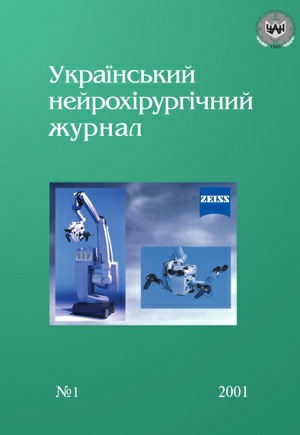Technique stabilization of spine after removal vascular tumor and malformations of spine
Keywords:
vascular formation of the spine, spinal stabilizationAbstract
The efficacy of surgical spine stabilization after removal of spinal vascular tumors and malformations is evaluated from a retrospective analysis of 37 case histories of patients. Neurovisual findings, clinical symptoms, surgical strategy, and instrumentation techniques of the spine are analyzed. Results of treatment patients with vascular tumors and malformations were assessed depending on method of spine stabilization.
The study concluded that preferred method of vertebral body reconstruction in case of anterior localization was the space after bone removal was packed with a titanium cage filled with bone fragments. The combination of a titanium cage and an anterior locking plate can be made easily for anterior spinal fusion with enough rigidity to maintain the necessary space during fusion without any major support equipment. Both edges of the titanium mesh cage cut into the vertebral body to hold the cage in place. The other part, the titanium plate, makes it secure until ceramic bone fragments in the cage promote bony ingrowth for fusion.
In case of posterior localization or lesions of posterior part of vertebral body the favorite method was a single midline posterior approach, and performed single-stage circumferential decompression of the theca followed by anterior and posterior reconstruction. A titanium mesh packed by bone fragments provides anterior support. Posterior reconstruction is achieved by placement of pedicle screw and rod instrumentation. We demonstrate the technique, feasibility, and success of vertebrectomy that is followed by anterior and posterior reconstruction via a simple posterior approach.
Conclusion. Adequate vertebroplasty and stabilization of the spine promote a more complete rehabilitation of patients and improve the quality of their life.
References
Cahill D.W., Kumar R. Palliative subtotal vertebrectomy with anterior and posterior reconstruction via a single posterior approach // J. Neurosurg. — 1999. — V.90 (1 Suppl). —P.42—47
Chen L.H., Chen W.J., Niu C.C., Shih C.H. Anterior reconstructive spinal surgery with Zielke instrumentation for metastatic malignancies of the spine // Arch. Orthop. Trauma. Surg. — 2000. —V.120., N1—2. —P.27—31.
Fourney D. R., Abi-Said D., Lang F.F., McCutcheon I.E. Use of pedicle screw fixation in the treatment of malignant spinal disease: experience in 100 consecutive procedures // J. Neurosurgery (Spine) — 2001. —V.94. — P.25—37.
Gokaslan Z.L., York J.E., Walsh G.L., McCutcheon I.E., Lang F.F., Putnam J.B. Jr., Wildrick D.M., Swisher S.G., Abi-Said D., Sawaya R Transthoracic vertebrectomy for metastatic spinal tumors // J Neurosurg — 1998. —V.89., N4. —P.599—609.
Jackson R.J., Gokaslan Z.L. Spinal-pelvic fixation in patients with lumbosacral neoplasms // J. Neurosurg — 2000. —V.92(1 Suppl). — P.61—70.
Kanayama M. Ng. , Cunningham B.W., Abumi K., Kaneda K., McAfee P.C. Biomechanical analysis of anterior versus circumferential spinal reconstruction for various anatomic stages of tumor lesions // Spine — 1999. —V.1, N24(5). — P.445—450.
Kinoshita A., Kataoka K., Taneda M. Multilevel vertebral body replacement with a titanium mesh spacer for aneurysmal bone cyst: technical note //Minim. Invasive Neurosurg. — 1999. — V.42, N3. —P.156—158.
McLain R.F., Kabins M., Weinstein J.N. VSP stabilization of lumbar neoplasm: technical consideration and complication //J. spinal disord. — 1991. —V.4. — P.359—365.
Miller D.J., Lang F.F., Walsh G.L., Abi-Said D., Wildrick D.M., Gokaslan Z.L. Coaxial double-lumen methylmethacrylate reconstruction in the anterior cervical and upper thoracic spine after tumor resection //J Neurosurg — 2000. —V.92 (2 Suppl). —P.181—190.
Ozaki T., Halm H., Hillmann A., Blasius S., Winkelmann W. Aneurysmal bone cysts of the spine //Arch. Orthop. Trauma. Surg. —1999. —V.119, N3—4. —P.159—162.
Pait T.G., Al-Mefty O., Boop F.A., Arnautovic K.I., Rahman S., Ceola W. Inside-outside technique for posterior occipitocervical spine instrumentation and stabilization: preliminary results// J. Neurosurg. — 1999. —V.90 (1 Suppl). —P.1—7.
Rajaraman V., Vingan R., Roth P., Heary R.F., Conklin L., Jacobs G.B. Visceral and vascular complications resulting from anterior lumbar interbody fusion//J. Neurosurg. —1999. —V.91 (1 Suppl). —P.60—64.
Rompe J.D., Hopf C.G., Eysel P. Outcome after palliative posterior surgery for metastatic disease of the spine — evaluation of 106 consecutive patients after decompression and stabilisation with the Cotrel-Dubousset instrumentation //Arch. Orthop. Trauma. Surg. —1999. —V.119, N7—8. —P.394—400.
Vinas F.C., Holdener H., Zamorano L., King P.K., Li Q., Jiang Z., Diaz F.G. Use of interactive-intraoperative guidance during vertebrectomy and anterior spinal fusion with instrumental fixation: technical note //Minim. Invasive. Neurosurg. —1998. —V.41, N3. —P.166 —171.
Downloads
How to Cite
Issue
Section
License
Copyright (c) 2001 Eugene Slynko

This work is licensed under a Creative Commons Attribution 4.0 International License.
Ukrainian Neurosurgical Journal abides by the CREATIVE COMMONS copyright rights and permissions for open access journals.
Authors, who are published in this Journal, agree to the following conditions:
1. The authors reserve the right to authorship of the work and pass the first publication right of this work to the Journal under the terms of Creative Commons Attribution License, which allows others to freely distribute the published research with the obligatory reference to the authors of the original work and the first publication of the work in this Journal.
2. The authors have the right to conclude separate supplement agreements that relate to non-exclusive work distribution in the form of which it has been published by the Journal (for example, to upload the work to the online storage of the Journal or publish it as part of a monograph), provided that the reference to the first publication of the work in this Journal is included.









